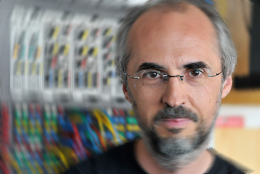Kitchen <-> Miniature(s)
2005-2006, 24 channels
Program Notes
A good quality sound recorder and a kitchen. Humanity tuned to common shapes and sizes that create shared resonances I have come to recognize everywhere there is a kitchen. These tightly chained miniatures explore a few of the many kitchen utensils and small appliances that I recorded (that is, anything that would fit with me inside my bedroom closet). Featured prominently through the piece is the mechanical timer of a toaster oven, as well as cookie sheets, plates, trivets, the klanging sound and inner resonances of the lid of a wok and many more kitchen instruments. More than 3000 lines of Common Lisp code are used to create large scale forms and detailed sound processing. Without Bill Schottstaedt's CLM (Common Lisp Music), Juan Pampin's ATS (Analysis, Transformation and Synthesis) and Rick Taube's Common Music this piece would not have existed. Grani (a granular synthesis software instrument) and other old software friends I have created over the years helped as well.
Tech Notes
The whole piece is written to soundfiles directly by a program. There is no separate mixing, equalization, postprocessing or spatialization done after the piece is rendered. All processing is done using the CM/CLM family of Common Lisp based composition and sound processing software running on top of the Linux operating system. No other equipment was used other than studio quality powered monitors. The piece itself (the score) is a Lisp program spanning more than 3000 lines. In addition to using CM/CLM the piece also uses the ATS (Analysis, Transformation, Synthesis) Common Lisp package to analyse, process and recreate recorded sounds. Several instruments and algorithmic processes written by the composer are also used in the compositional process.
The spatialization does not use explicit panning but rather treats the speakers as point sources in space. Movement in space is a side effect of the way synthesis, resynthesis and granulation techniques are used throughout the piece. Partials and sound grains are distributed over the "speaker space" in various ways, and their distribution changes dynamically over time, giving rise to spatial movement that is spectrally distributed over the space surrounding the audience.
The original version of this piece is rendered to be played back on a 24 speaker three dimentional diffusion system (24 individual 24bit 48KHz soundfiles) and was mixed and created in the Listening Room at CCRMA, a 3D room with 16 speakers (4 hanging from the ceiling, 8 at ear level and 4 below the floor).
Performances
- 40, 50, 80 - CCRMA en Montevideo, November 11, 2014, eMe, Montevideo, Uruguay
- Semana del Sonido, La Plata, Argentina, August 20-24 2013
- Sonic Boom! concert, Bing Concert Hall, Stanford University, March 16 2013
- Transitions: Acousmatic: Soundscapes under the stars, CCRMA Backyard, September 28th 2011
- ICMC2008 (International Computer Music Conference), Belfast, Northern Ireland, August 27th, 2008
- Ultraschall Festival, Berlin, Germany, January 25th 2008
- LAC2007 (Linux Audio Conference 2007), Berlin, Germany
- Newstage Festival: Electroacoustic Concert, CCRMA, April 28th 2006 (premiere)
Fernando Lopez-Lezcano

Composer, performer, lecturer and computer systems administrator at CCRMA, Stanford University
Quick Links
El Dinosaurio
Applesauce Modular Mark V
Planet CCRMA
Music & Performances
Of Dinosaurs and Other Creatures
The Well Modulated Dinosaur
The Love Songs of Flying Dinosaurs
El PianoSaurio
Dinosaur He[a]rd!
Wings
Resurrections
Pia[NOT] Etude
The Miraculous Multiplication of Strings
Y Sonó Como Arpa Vieja
Un Esqueleto en la Cocina
The Hidden and Mysterious Machinery of Sound
Modulate me, please?
Space, S[acred|ecular]
Vox Voxel
Toast and Jam
Divertimento de Cocina
Velvet Skin, Heart of Steel
Fugue 1 (Fanfare)
Jurassic Modulations
Earth Songs
Dinosaur Skin
A Very Fractal Cat, Somewhat T[h]rilled
65 Second Bycicle
The Dinosaur At War
Exit Variations
El Dinosaurio Habla
Kitchen <-> Miniature(s)
Instant Knoll
iICEsCcRrEeAaMm
House of Mirrors
With Room to Grow
Knock knock, anybody there?
Three Dreams
Espresso Machine II
Hot'n Cold
Quest
(C)1993-2023 Fernando Lopez-Lezcano. All Rights Reserved.